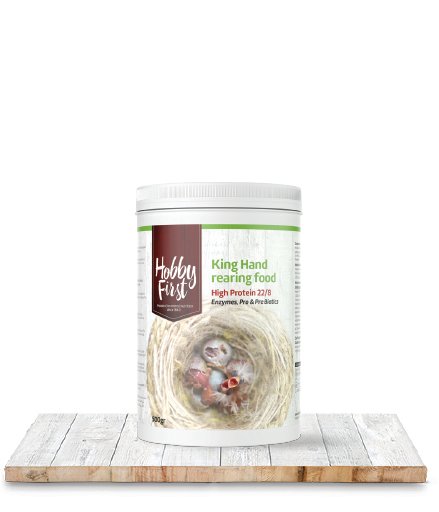
Hand Rearing Food - High Protein 22/8
User guide:
• HobbyFirst Hand Rearing Food must always be prepared with lukewarm water (37 °C)! In the beginning, the thin porridge must be injected with a syringe. As the young birds get older, prepare a thicker porridge (see table). Make sure that the crop of the bird is always empty between two feeds.
• Mix the Hand Rearing Food and the lukewarm water in a clean bowl according to the volume recommended in the table. (We always recommend weighing the mix and water to ensure correct concentrations). Tap water may contain harmful bacteria and therefore we recommend boiling the water before use or using bottled water.
• The mixture should be stirred vigorously so that water and feed do not separate. Leave to rest for a minute. If you have prepared the mixture correctly, you will get a nice porridge
• Important: the mixture must be freshly prepared for each meal! It is therefore best to prepare the mixture in small quantities. DO NOT USE MIXED FOOD AFTER EVERY MEAT! To prevent bacterial growth, throw away all unused mixed food after each feeding.
• Feed until the crop of the chick is nicely rounded or, in older chicks, until it refuses more feed. Usually, each meal consists of a volume equivalent to 10-12% of the bird’s body weight. When feeding baby birds, you should wait between feedings until the chick’s crop is empty (or almost empty) and determine whether the bird is getting the right amount of feed. This will prevent the food remaining in the crop too long and possibly spoiling it. We recommend that the crop of the baby bird is emptied completely at least once a day.
Hand Rearing Food - High Protein 22/8
King Hand Rearing Food is based on carefully selected and highly digestible ingredients. Contains probiotics and organic acids that help maintain a healthy population of gut microorganisms and an ideal crop environment. It also contains digestive enzymes for proper digestion of carbohydrates and proteins. King Hand Rearing Food is finely ground to make it easier to administer with a syringe and remains very well in suspension: this improves the digestion and absorption of the feed.
High Protein 22/8
Art. nr. 754408 - 500 GR
• This hand rearing food is ideal for birds requiring a higher protein level (22%) and a lower fat content (8%)
• Ideal for bird species with a high protein requirement such as Amazon parrots, cockatoos, cockatiels, large parakeets and dwarf parrots ...
• Also for smaller birds such as canaries, tropical finches, budgies ...
• Also perfectly suitable as a supplementary feed for sick birds, birds left behind in the nest, birds found in the wild or orphans

User guide:
• HobbyFirst Hand Rearing Food must always be prepared with lukewarm water (37 °C)! In the beginning, the thin porridge must be injected with a syringe. As the young birds get older, prepare a thicker porridge (see table). Make sure that the crop of the bird is always empty between two feeds.
• Mix the Hand Rearing Food and the lukewarm water in a clean bowl according to the volume recommended in the table. (We always recommend weighing the mix and water to ensure correct concentrations). Tap water may contain harmful bacteria and therefore we recommend boiling the water before use or using bottled water.
• The mixture should be stirred vigorously so that water and feed do not separate. Leave to rest for a minute. If you have prepared the mixture correctly, you will get a nice porridge
• Important: the mixture must be freshly prepared for each meal! It is therefore best to prepare the mixture in small quantities. DO NOT USE MIXED FOOD AFTER EVERY MEAT! To prevent bacterial growth, throw away all unused mixed food after each feeding.
• Feed until the crop of the chick is nicely rounded or, in older chicks, until it refuses more feed. Usually, each meal consists of a volume equivalent to 10-12% of the bird’s body weight. When feeding baby birds, you should wait between feedings until the chick’s crop is empty (or almost empty) and determine whether the bird is getting the right amount of feed. This will prevent the food remaining in the crop too long and possibly spoiling it. We recommend that the crop of the baby bird is emptied completely at least once a day.